When the first European settlers reached the place now known as New York City, they found a land consisting of forests, grassland, and wetland marshes and ponds. At the time, they would have encountered a diverse group of native plants, some of which would have been totally unfamiliar to the European colonists. Nearly 400 years later, the landscape has been reshaped. Development made New York City into the thriving metropolis full of skyscrapers and city sidewalks that we know today.
However, when the European colonists were forming the first settlement, a young tree sapling was also growing nearby. Incredibly, this tree still stands in New York City today. At over 133 feet tall, and hundreds of years old, it is now the tallest, and oldest, tree in New York City. Let’s learn together about this old, strong tree standing tall in New York City today. Along the way, we will explore some of New York City’s history and ecology.
The Tallest Tree in New York City
The tallest tree in New York City is a tulip tree (the species Liriodendron tulipifera). This tulip tree is suspected to be both the tallest and oldest organism growing in the city – and it is estimated to be almost 400 years old! Known as the “Alley Pond Giant” or “Queens Giant,” this tree reached 133.8 feet tall with a girth of 18.6 feet in the year 2000. By the year 2004, the Alley Pond Giant had reached 134 feet tall. Today, it is still growing! 134 feet is about the equivalent of a 13-story building – making the tree not quite as tall as some of the city’s skyscrapers, but still a hulking behemoth!
Located in the Alley Pond Park, this Alley Pond Giant grows tall in the borough of Queens, living between Douglaston and Bayside. The tree stands just a few feet away from the Cross Island Parkway. Experts date the age of the tree between 360 and 450 years old. The New York City Parks Department claims that the tree is at least 368 years old, based on historical records. In fact, it is believed that this long-standing tree was actually part of a 17th-century gift from the Dutch West India Company to the Manhattan Walloon families.
“To know that this tree has existed [since] before the United States became a nation is astounding,” says Sgt. Victor Yin, a city urban park ranger.
Thankfully, tulip trees are strong and need very little maintenance. Even at its age and size, the Alley Pond Giant is fairly easy for the New York City Parks Department to care for. The only challenge is keeping it safe – from people. Visitors can find the tree near the Douglaston Plaza Mall. You may see the tree by traveling on foot from Alley Pond Park.
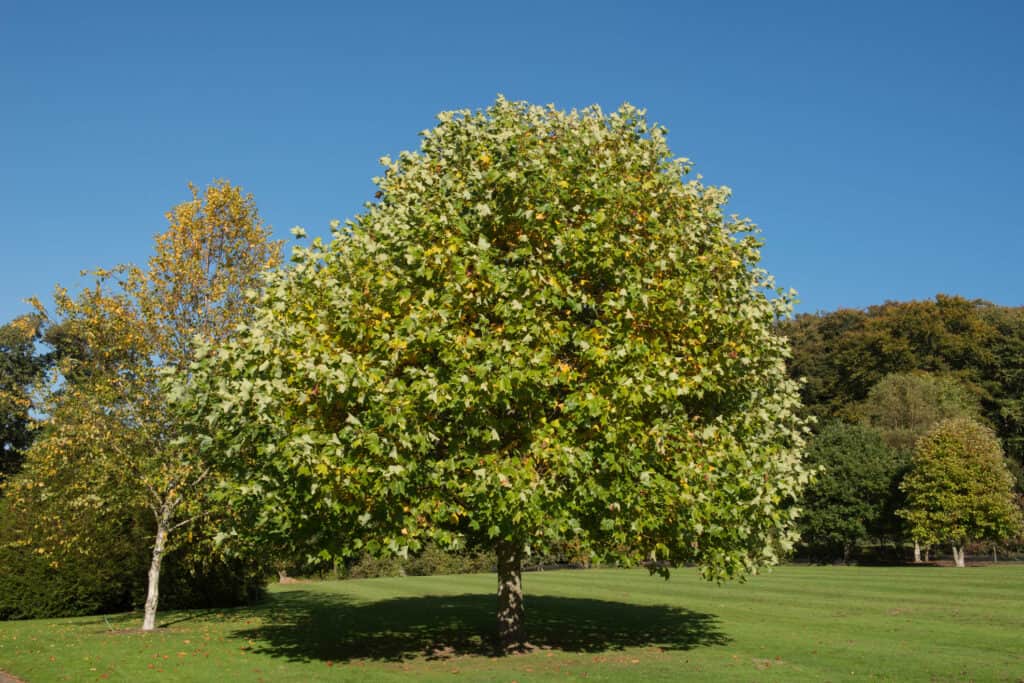
The tallest tree in New York City is a 134-foot-tall tulip poplar tree.
©iStock.com/pcturner71
About Alley Pond Park
The tallest tree in New York City grows in Alley Pond Park. Alley Pond Park is the second-largest public park in Queens, New York City. This public park occupies 655.3 acres, which allow visitors to enjoy scenic views and walking trails.
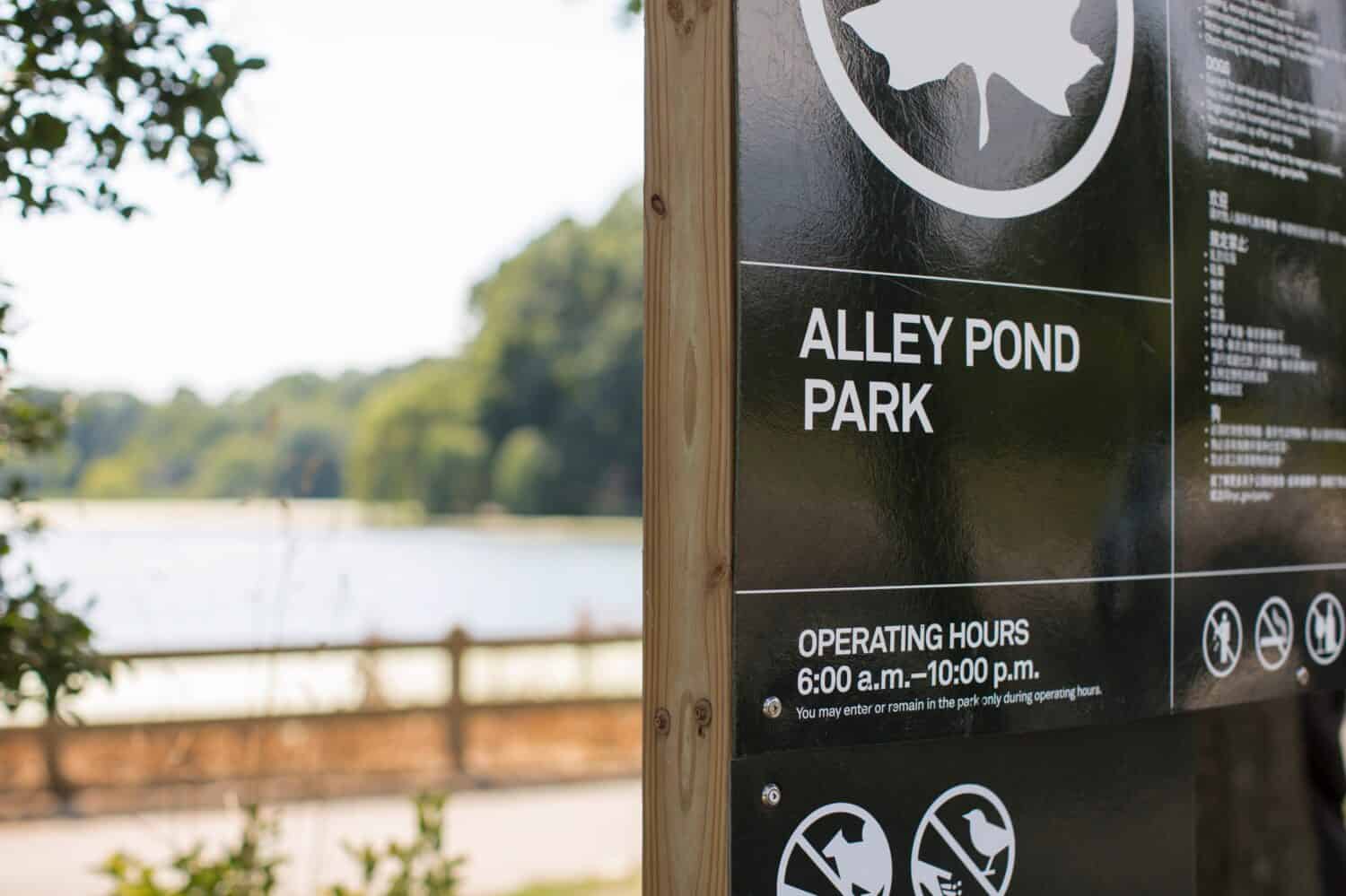
The tallest tree in New York City grows in Alley Pond Park, in Queens.
©JaysonPhotography/Shutterstock.com
About Tulip Trees
The Alley Pond Giant, the tallest tree in New York City, is a tulip tree. Tulip trees, also known by their scientific name of Liriodendron tulipifera, are also called “yellow polar” trees. This is a deciduous tree species known for growing to heights as great as 100 to 150 feet tall. These trees are native to the Eastern parts of North America, where they thrive in moist, organically-rich soil. These trees blossom with beautiful yellow blooms with bright orange bands of color across the petals. These flowers attract birds and hummingbirds, who feed on their delicious nectar.
Liriodendron tulipifera belong to the Magnolia family Magnoliaceae. They are among the most beautiful eastern hardwood trees, and one that produces beautiful blossoms. In general, these trees have long, straight trunks, which allow the trees to reach staggering heights. The leaves are green, but turn a bright golden color during the fall. Tulip trees are a favorite for birds nesting in the branches and these trees are a welcome habitat for numerous creatures.
In New York City, this Alley Pond Giant is just one of an amazing 5.2 million trees growing in the city. Though it would be hard to verify whether it is actually the oldest organism growing in the city, it is certainly among the most tenured specimens in the area.
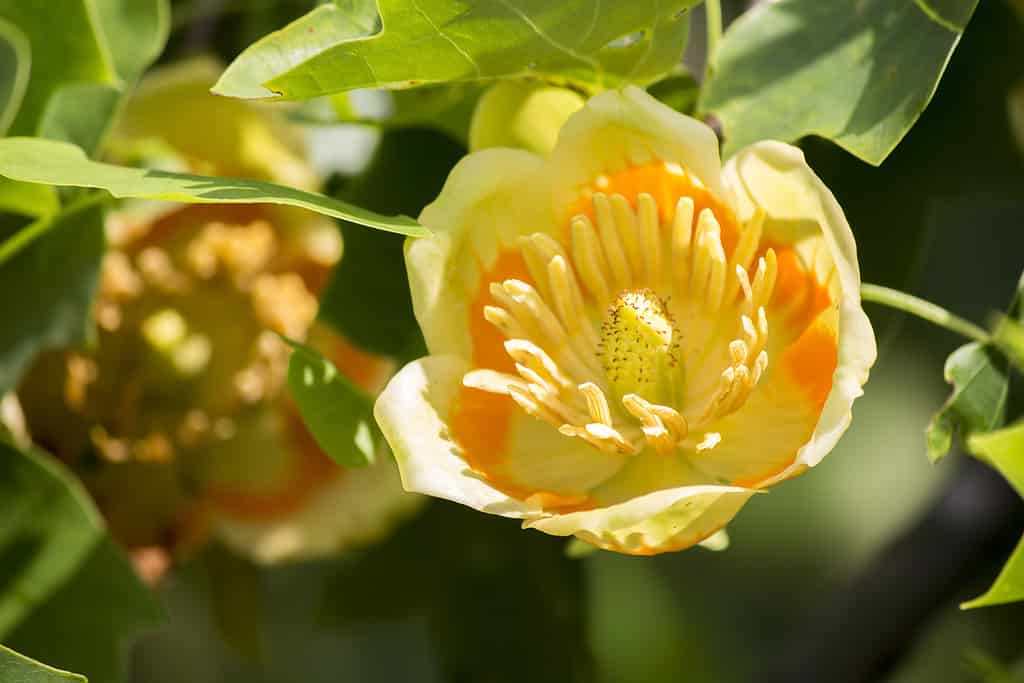
The tallest tree in New York City is a tulip tree that blossoms with beautiful showy yellow blooms.
©iStock.com/Jim Still-Pepper
Where Tulip Trees Grow
Tulip trees are among the largest native trees that grow in North America. They are native to the central and eastern parts of the United States, as well as parts of Canada. Tulip trees grow naturally in forests and swamps. Since New York City was built on land that originally consisted of swampy wetlands, forests, and grassland, it makes sense that the Alley Pond Giant would thrive in New York City’s soil. Generally, tulip trees do grow well in deep, moist soils along streams and marshy areas.
Fun fact: Liriodendron tulipifera is the state tree of Kentucky, Tennessee, and Indiana.
History of New York City
Back in the 17th century, the Dutch West India Company sent a group of families to colonize the “new world” they called “New Amsterdam.” These Walloon Settlers were a group of 32 Belgian Huguenot families. They embarked on a long journey with the Dutch to cross the Atlantic Ocean on a ship called “Nieu Nederland” (New Netherland). Together, they set sail to colonize New Amsterdam. The Waloons first fled religious persecution in Belgium to nearby Holland. Then, a leader named Jesse de Forest, solicited the Dutch West India Company to gain permission to settle in a new colony.
On May 20, 1624, they arrived on the land that is present-day New York City. The colony was called New Amsterdam. It became a chartered city in 1653 and became under British control in 1664. At that time, the English colonists renamed the land “New York,” after King Charles II granted the land to his brother, the current Duke of York.
Since 1674, people near and far have known the growing city as “New York.” From the beginning, the city had an important place in history and culture – even serving as the capital of the U.S. briefly, from 1785 to 1790. This preeminent American city has long been a hub of culture and commerce. Since 1790, it has also been the most populated U.S. city.
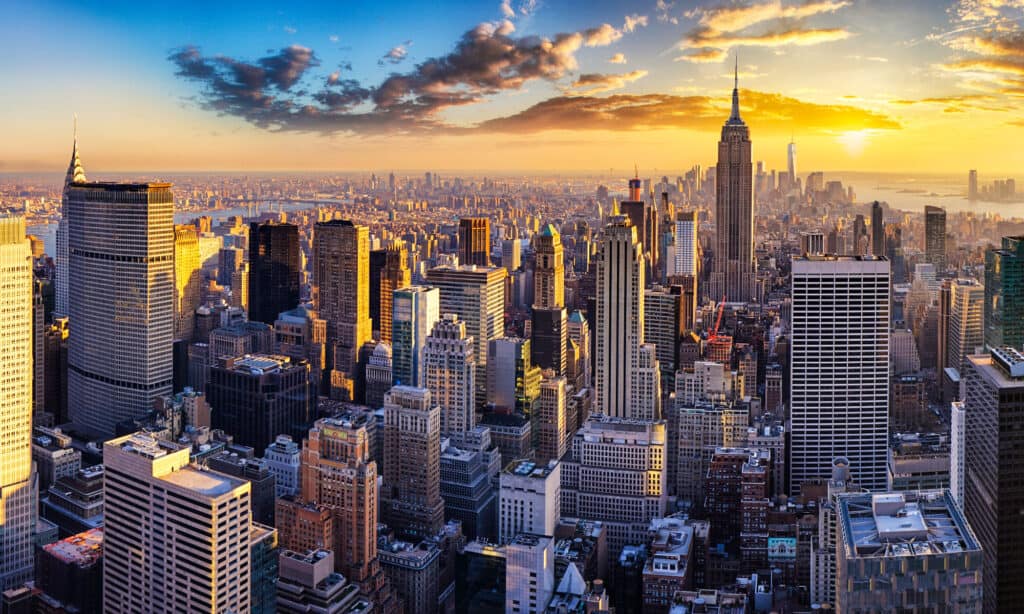
New York City is the most populated city in the U.S.
©iStock.com/TomasSereda
Ecosystems in New York City
New York City consists of hundreds of diverse neighborhoods, grouped into five boroughs. Each borough has its own unique history and community character setting it apart from the others. These five boroughs are Manhattan, Brooklyn, Queens, the Bronx, and Staten Island. Each of these boroughs also contains diverse ecosystems. While some may imagine that a city as big and bustling as New York City is devoid of wildlife, this could not be further from the truth! New York City’s five boroughs have forests, meadows, freshwater and saltwater wetlands, and cultivated garden areas. The forests themselves are diverse, with New York City’s boroughs including floodplain forest, red maple-hardwood swampland, rich forest, successional forest, and oak-hickory forest. These urban ecosystems are the home for numerous native plants and diverse wildlife.
Forests
New York City’s forests are far more than just trees! Each of New York’s forest areas are comprised of multiple species of trees, animals, and other native plants. In New York City, the forests are big and small, and offer many benefits to the city’s people and wildlife. Not only do trees provides homes for birds, but the forest floor hosts animals like mice, frogs, turtles, insects, and worms. The forest canopy is the place for birds to nest and sleep, including species like red northern cardinals, woodpeckers, and others. You might also see animals like owls, raccoons, and squirrels! The trees in New York City’s forests filter the air, absorb stormwater, remove carbon dioxide, and help build a healthy city.
Grasslands
New York City’s grassland areas contain wildflowers, grass species, and animals. Though these grasslands are more rare in New York City than forests and wetlands, they are still an important wildlife habitat. Rather than being dominated by trees, the grasslands are dominated by shrubby plants and non-woody herbs and grasses. The biggest grassland areas in New York City are located in Brooklyn and Staten Island. These were actually human creations. They were originally salt marshes that were once filled in, and now have been returned to a wilder state and planted with grasses. New York City’s grasslands offer habitats for species like grasshopper sparrows, savannah sparrows, meadowlarks, pheasants, and pollinators like the beautiful monarch butterfly! They also help to absorb carbon and provide wide open space for hiking and birdwatching.
Wetlands
New York City has both freshwater and saltwater wetlands. These ponds, swamps, and salt marshes are fun places where unique plants and animals make their home. Wetlands are also a great place to find amphibians and other water-loving creatures! New York City has thousands of acres of wetlands, including tidal wetlands like saltmarshes, which are flooded by tides.
Though there are wetlands in all five New York City boroughs, many of the freshwater wetlands are in Staten Island. These wetlands are important wildlife habitats, especially for reptiles and amphibians. They help to protect the coastal communities, absorb CO2 from the atmosphere, reduce the impact of urban heat, and of course, provide plenty of chances for fun and relaxation! Sadly, the 5,650 acres of wetlands that still exist in New York are far less than what existed before European settlement in the area. This has led to the loss of enormous swaths of freshwater wetland habitat.
Animals that Live Near the Tallest Tree in New York City
In the areas surrounding the Alley Pond Giant, the tallest tree in New York City, you can find many creatures making their homes. In fact, although New York City is sometimes called a “concrete jungle,” there are many thousands of animal species that live and thrive throughout the city’s parks and urban habitats.
Among the mammals that live in or around New York City are bats, coyotes, eastern chipmunks, eastern gray squirrels, raccoons, red foxes, seals, skunks, opossums, white-tailed deer, and others.
New York is also a great place for birdwatching! You may see bird species such as American kestrels, bald eagles, Canada geese, eastern wild turkeys, great egrets, mallard ducks, ospreys, owls, peregrine falcons, pigeons, piping plovers, red-tailed hawks, terns, and woodcocks.
If you prefer your creatures cold-blooded, have no fear! New York is home to many reptiles. Look out for eastern box turtles, diamondback terrapins, painted turtles, red-eared sliders, and snapping turtles. The amphibian species in New York’s wetlands include Atlantic coast leopard frogs, red-backed salamanders, spotted salamanders, and spring peepers.
When you look in the rivers, ponds, and freshwater waterways around New York, you can find diverse aquatic creatures too! These include American eels, horseshoe crabs, river herring, and sunfish.
Then, do not forget the insects that also play an important role in the New York City ecosystem! The city is home to Asian long-horned beetles, bees, dragonflies and damselflies, emerald ash borer, monarch butterflies, spotted lanternflies, and others.
This list of creatures is just skimming the surface! If you visit New York or take a stroll by the Alley Pond Giant, look out for these creatures or others who make their home in the city and its many parks.
About the New York City Department of Parks and Recreation
Do not think that a visit or move to New York City means saying goodbye to nature! The New York City Department of Parks and Recreation stewards and manages over 30,000 acres of land. These 30,000 acres represent 14% of all of New York City! From Coney Island Beach and Central Park to numerous community gardens, New York City is full of green space. There are over 600,000 trees plant along New York City streets. More than 2 million trees grow in the city’s parks. There are gardens, beaches, nature centers, and monuments.
With so much nature to care for, the Department’s vision is to create and sustain thriving parks and public spaces for New Yorkers. They execute this vision by planning “resilient and sustainable parks, public spaces, and recreational amenities,” with work building “a park system for present and future generations” and caring for all of the parks and public spaces.
Learn more about visiting the New York City parks here: NYC Parks Rules & Regulations, Park Notices, Health & Safety Guide.
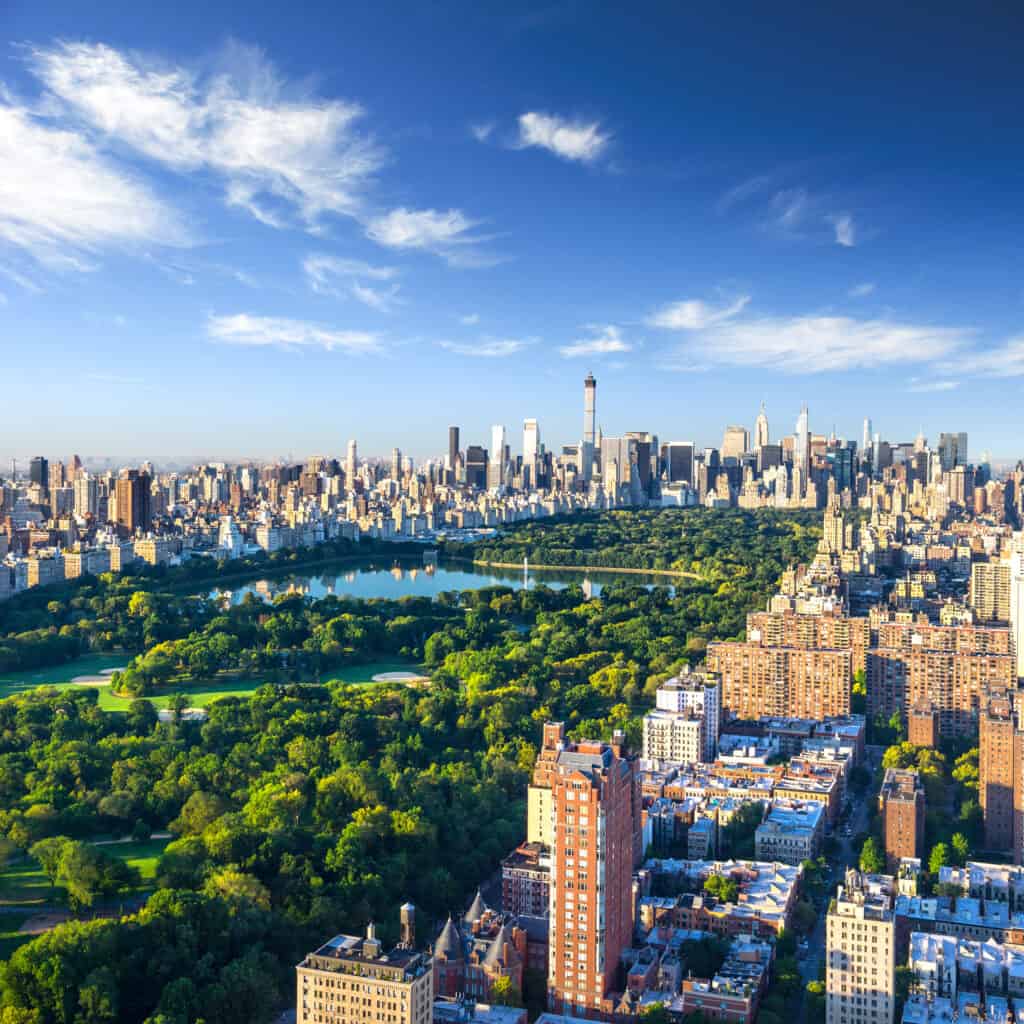
One of New York City’s most famous parks is Central Park.
©IM_photo/Shutterstock.com
The Tallest Tree in New York (State)
While the Alley Pond Giant may be the tallest tree in New York City, the state of New York is also home to some behemoth trees. In fact, the tallest tree in New York was a white pine that recently fell. This tree, known as Tree 103, was a mighty giant itself. It stood at 164 feet and 7 inches tall. It had lived for hundreds of years. However, giant pines typically do not last longer than 300 years or so. Although this tall tree recently fell to the ground, it lives on. The tree’s wood debris is now part of the forest, providing a home for insects and fungi to continue the forest’s circle of generation and decomposition.
Now the designation of New York’s tallest tree belongs to a towering 174-foot white pine near the town of Bolton by Lake George. This tall, rare tree gained the nickname of “Little Foot Pine” for having a small base.
The photo featured at the top of this post is © Peter Turner Photography/Shutterstock.com
Thank you for reading! Have some feedback for us? Contact the AZ Animals editorial team.






